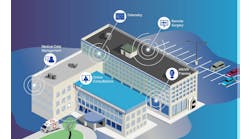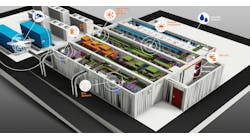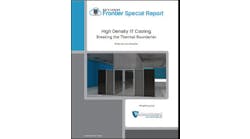Data-Driven M&A Expands Across Data Centers, Wireless, Fiber, Towers
The digital transformation will create opportunities across a broad range of infrastructure. Investors are sharpening their focus on multi-sector strategies that spread investment across the entire spectrum of digital infrastructure assets, including data centers, telecom towers, wireless antennas and fiber.
That trend is clearly visible in two deals announced in in recent weeks: The acquisition of Zayo Networks by Digital Colony and EQT, and American Tower’s purchase of Colo ATL. These transactions continue the crossover between the wireless, fiber and data center businesses, a trend we first noted in our 2018 Forecast. This trend is bringing new investors into the data center sector, as they seek to balance the opportunities and valuations presented by the different classes of data-focused infrastructure assets.
The gradual emergence of edge computing and 5G wireless networks will enable new technologies that shift IT infrastructure outside of core markets, and require additional integration between data centers, telecom towers and antennas. Analytics for new technologies will require processing and storage, sorting oceans of sensor data into smaller datasets to send across the network.
Digital Colony to Acquire Zayo
Digital Colony may be a new name for some followers of the data center sector. But as with other recent market entrants, the company features an experienced leadership team and financial backers with deep pockets.
On Monday, Digital Colony teamed with Swedish infrastructure fund EQT Partners to acquire publicly-held telecom and data center provider Zayo Group and take the company private. The deal values Zayo at $35 a share, or about $14.5 billion, including the assumption of $5.9 billion of Zayo’s debt.
Zayo operates a 130,000-mile all-fiber network in North America and Europe, along with its zColo colocation business, which operates 51 data centers and more than 1 million square feet of data center space.
Digital Colony is a company formed by Digital Bridge and Colony Capital to acquire digital assets. Both Digital Colony and Digital Bridge invest across four key segments that define mobile and internet infrastructure – towers, data centers, small cells, and fiber – which each play an important role in digital transformation and how information is consumed.
Digital Bridge owns and operates two data center platforms – DataBank in retail colocation, and Vantage Data Centers in the wholesale/hyperscale space. Principals Marc Ganzi and Chairman Ben Jenkins previously founded Global Tower Partners (GTP), the largest privately-owned operators of telecom towers.
With Digital Colony, the Digital Bridge team is being backed by Colony Capital, a real estate investment management firm led by Thomas Barrack Jr., an experienced private equity executive.
“Zayo has a world-class digital infrastructure portfolio, including a highly-dense fiber network in some of the world’s most important metro markets,” said Ganzi. ” We believe the company has a unique opportunity to meet the growing demand for data associated with the connectivity and backhaul requirements of a range of customers. We are excited to work alongside the management team and EQT to grow the business and expand its presence in the global market.”
On May 1, Digital Colony finalized its acquisition of Cogeco Peer 1, a leading Canadian provider of fiber and data center assets.
American Tower: Colo as an Edge Strategy
American Tower was actively exploring opportunities in edge computing even before it acquired Colo ATL for $70 million, or about 15 times EDITDA, CEO Jim Taiclet told investors in the company’s earnings call.
“As information processing progressively moves to the network edge, we expect there to be a greater need for lower latency through distributed storage and compute functionality in close proximity to both wireless and wireline consumers,” said Taiclet. “We have been evaluating this for some time, and have an ongoing edge compute trials at several of our tower sites.”
American Tower operates more than 170,000 wireless infrastructure sites across 17 countries on five continents, including nearly 40,000 in the United States, and had more than $7.3 billion in revenue in 2018. In addition to leasing space on towers, American Tower provides access to in-building systems, outdoor distributed antenna systems (DAS), managed rooftops and services that speed network deployment.
American Tower clearly wants to monetize edge capacity at its thousands of tower sites. The Colo ATL acquisition is a beachhead in a new sector, and a bet that the earliest edge growth may involve creating denser networks in cities. Taiclet said the deal provides the company “a look at the early stages of the cloud evolution to the EDGE that we expect to see accelerate the future.”
“Colo ATL affords us the opportunity to learn firsthand about the evolution of connectivity for consumers’ devices, IoT units and autonomous vehicles to the cloud,” said Taiclet. “This includes direct and interactive knowledge of potential future tenant needs, key trends like cloud gaming technology developments, like hybrid cloud and a host of other aspects that we could not evaluate and prototype with partners without owning an asset like this.
“At the same time, I will emphasize to everyone that projects like Colo ATL do not indicate a shift in strategy or a material pivot in focus for American Tower,” he added. “On the contrary, our innovation investments are designed primarily to drive additional tenant leasing growth on our tower and in-building systems, whether it be from existing or new customers and adjacent assets that enhance the leasing value and potential of the tower.”
In other words, as digital infrastructure becomes more distributed, colocation may drive more value to towers. Options for American Tower include partnering as well as acquisitions.
“I think there is a great opportunity for us to bring our asset base, which is the 40,000 US towers and the 330 or 340 indoor DAS systems we have in the US, to a partner who brings something else, which could be spectrum, could be cloud compute capability, could be existing big larger data centers,” said Taiclet. “Any of those are possible.”







